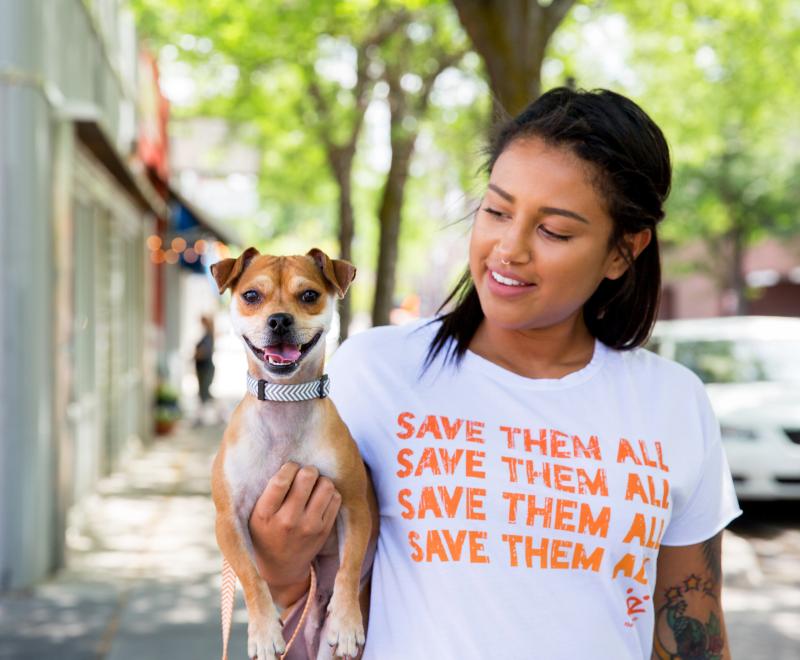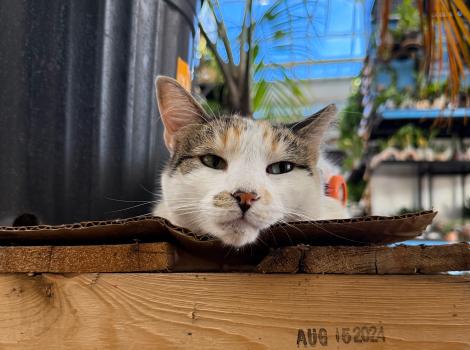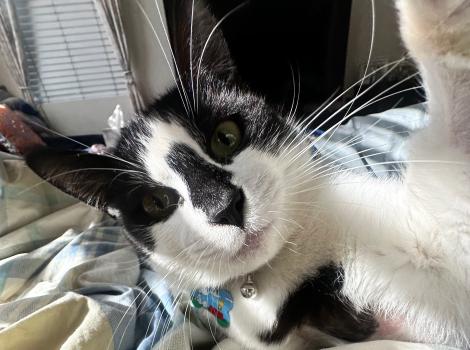Faces of No-Kill: Befriending a fractious feline

The Faces of No-Kill series highlights stories about pets who have become a statistic in the best way. These are just a few of the many pets who once slipped into danger; they lost their homes, they had health or behavioral challenges, their families couldn’t care for them, or all the above. But each one of them got assistance, and today they are thriving thanks to an animal shelter program that helped them rather than killed them. Best Friends’ goal is for every animal shelter and every community to reach no-kill by 2025. The story below is just one example of why it’s so important.
It started out as a lunch break like any other. Finishing up her meal, caregiver Emily Garcia reclined on the break room couch to enjoy some quiet time and casual phone browsing — a good way to relax in between the hustle and bustle of feeding, medicating, and cleaning up after her fuzzy feline charges. Then, a flash of black fur and white whiskers as a light weight settled onto her chest.
Cats joining in for lunchtime lounging and (attempted) taste-testing of any good-smelling food is nothing unusual for staff at Best Friends Animal Sanctuary’s Cat World. The cats love turning downtime into “pet me” time. And for the people, well, is there anything better than a cuddly companion to help you wind down?
But Emily’s breaktime buddy wasn’t just any cat. She’d been joined by Petey, a distinguished older gentleman who’d never really been known for his snuggly side. In fact, even before landing at the Sanctuary, Petey had developed a reputation for being a bit fractious and hands-off. So this moment of casual, calm connection was extra special. Emily had been working with him, trying to help him calm down and open up, and it seemed that was paying off. Sometimes, all it takes is some extra patience and a bit of TLC to turn a pet’s life around.

Healing the body to help the mind
Petey arrived at the Sanctuary with a few disclaimers. He’d been a big city kitty, coming from New York, where he’d ended up in a shelter and showed all sorts of stressed-out behaviors, from hissing and swatting to stalking after cats and people alike — especially if someone wanted to touch him. That made it worse when he needed hands-on medical care.
He'd been diagnosed with hyperthyroidism, but trying to get the transdermal medication on his ear (so it could absorb through his skin) was difficult when he was squirming and doing everything he could to get away. He often went off his food, showing no signs of an appetite while also regularly throwing up. It was, obviously, rough on him as well as the people who just wanted him to feel better.
At the Sanctuary, relatively quiet as it is, caregivers would have the time to really figure out how to help the frantic feline. Petey got his own room, so he wouldn’t have to worry about raucous roommates. But it was hard to get comfortable with so many new people, especially when they still had to handle him for medications.
[14-year-old cat with hyperthyroidism gets treatment and a family to call her own]
Caregivers tried distracting Petey with treats while they rubbed his medication on his ear. They tried a swab on a long stick, so he wouldn’t get anxious about hands coming toward him — anything to try to get the crucial medicine to him with the least amount of stress. Trying to get a pill into his mouth directly was out of the question, but then came the solution: This particular medication could be compounded in a tuna flavor and sprinkled in his food.
Then the problem was just finding food that Petey would eat. It took trial and error (and some tasty “junk food”) to find the right flavors for his refined palette, but finally caregivers found enough options he enjoyed to get him eating regularly. Being less stressed about all that medical handling certainly helped, too.
Once Petey had a consistently full belly, and he was getting his full dose of thyroid medication every day without all the fuss of hands all over him, he started to relax. Not enough to want scratches and cuddles, but with his body feeling better and some space to realize these new people weren’t going to do anything he didn’t want done, he could start opening up.

Operation: Befriend Petey
As Petey got his appetite back and started settling into his home-between-homes, it was time to reintroduce him to the idea of making human friends. Emily took Petey on as her project cat, laying out 30-, 60-, and 90-day goals for her furry friend. The first step was just getting him comfortable with any kind of human interaction.
“I started really slow with him, just sitting in the room with him, talking to him a little bit,” Emily explains. “Really just being in his presence.” And that’s all it was: sitting in Petey’s room, letting him sniff and approach and wander off in his own time without any expectation of touch — just letting him know that it was OK to be around someone like this. So for 10 to 15 minutes three to four days a week, that was part of Emily’s job: sitting with Petey.
With that quiet approach, Petey began to warm up. He was comfortable with Emily in the room, and when she finally reached her hand up in offering, he rubbed his head against it. “It got to the point where he would kind of step on my lap,” Emily says. “But then he would stop himself and not sit on me.”
[Cat goes from shy to showman]
Emily also brought treats into the equation. Discovering Petey’s love for Churu — a wet food treat in a tube — really helped him get invested in the whole process. Distracted by his yummy snack, Petey even arched up and leaned into the extra joy of some soft petting. “As long as he comes up to me,” Emily adds. “I don’t ever try to force anything like that. I let him take charge of those interactions.”
And petting? That was the 60-day goal for Petey, reached several weeks early. The 90-day goal of getting Petey into a stroller and out on some nature walks came quicky on the heels of that success. He’d completely blown the timeline out of the water.
He wasn’t a big fan of getting picked up and put into the stroller or loaded into a carrier to go hang out in his very favorite spot: the exercise pen set up outside for the cats to roll in the sand and chew on some cat-safe plants. But catnip and treats eased the way there.
And then, the world was open to Petey.
A family for a finicky feline
With a blossoming friendship with Emily, and the confidence grown from being given space and time, Petey’s general anxiety calmed way down. Though still prone to the occasional overstimulated swat if there was too much going on around him, Petey’s caregivers had figured out how to recognize when he was getting to that threshold, and they knew ways to redirect him to more positive experiences.
Instead of stalking after people defensively, Petey even started following strangers through the halls with curiosity (and the hope of a treat), and he tried to join in on large staff meetings. He walked with his tail held high behind him, green eyes studying new faces that passed, and only ever grabbed at a pant leg if he wasn’t given his due deference.
And when an adopter came looking for a senior cat — an adopter who had experience with fractious and feral kitties alike, as well as a calm and quiet home environment — Emily knew just who to introduce her to. “I had her meet him that day, and we sat with him. I told her about when he first got here and how he’s doing now,” Emily explains.
Petey rubbed against the new person’s hand — and then gave her a swat. But she took it all in stride and respected the boundaries he’d set. He was just right exactly as he was, and she knew she could give him all the time and space he needed to enjoy his golden years.
So now, Petey is home, enjoying two large catios and a family of his own. In his own time. When he wants to. Which is just what he needed.

Let's make every shelter and every community no-kill by 2025
Our goal at Best Friends is to support all animal shelters in the U.S. in reaching no-kill by 2025. No-kill means saving every dog and cat in a shelter who can be saved, accounting for community safety and good quality of life for pets.
Shelter staff can’t do it alone. Saving animals in shelters is everyone’s responsibility, and it takes support and participation from the community. No-kill is possible when we work together thoughtfully, honestly, and collaboratively.






